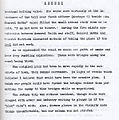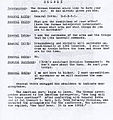Karl Veith
Karl Veith (born July 16, 1894 in Kempten ; † August 10, 1979 in Ochsenfeld ) was a German officer , most recently in the rank of lieutenant general as commander of the flak school division in Braunschweig and as the last combat commander in Braunschweig in World War II . On April 10, 1945, Veith led surrender negotiations to surrender the city to the 30th US Infantry Division under their commanding General Leland S. Hobbs . However, the negotiations failed after twenty minutes.
Life
Veith joined the 4th field artillery regiment "König" of the Bavarian Army in Augsburg on July 10, 1914 as a flag junior . After the outbreak of the First World War he took part with this association in the border battles and the Battle of Lorraine .
Promotions
- 1st July 1914 ensign
- September 19, 1914 Lieutenant
- 4th July 1918 First Lieutenant
- February 1, 1928 Captain / Rittmeister
- January 1, 1935 Major
- October 1, 1937 Lieutenant Colonel
- 1st August 1939 Colonel
- February 1, 1943 Major General
- 1st November 1944 Lieutenant General
After his promotion to lieutenant he was used as a battery officer and platoon leader . In July 1915, Veith was transferred to the air force and trained as an observer in Schleissheim . In November 1915 he came back into the field on the Western Front and was used there from February 1916 with the AFA 103b. With his promotion to first lieutenant on July 4, 1918, he was transferred to the staff of the Commander of Flieger 6 as a photo officer . His achievements were recognized by the award of both classes of the Iron Cross and the Order of Military Merit IV Class with Swords.
After the end of the war, Veith initially worked for a free formation in Fürth and in the “ Fahrmbacher ” Freikorps . In mid-June 1919 he was transferred to the provisional Reichswehr , where Veith served in the Reichswehr Infantry Regiment 44 and later in the Reichswehr Infantry Regiment 22. With the formation of the Reichswehr, Veith was transferred to the 7th Artillery Regiment , to which he belonged until his departure on March 31, 1928.
From April 1, 1928 to September 30, 1931, he worked at the Secret Aviation School and test site of the Reichswehr in Lipetsk , Russia . Then Veith was taken back into active service, initially being squadron chief of the driving department of the 3rd (Prussian) medical department in Berlin and, from October 1, 1932, battery chief in the 5th artillery regiment . On October 1, 1935, Veith joined the Air Force as commander of the 1st Battalion of Flak Regiment 5 . In the following years until the end of the Second World War he was with the following units: The Flak Brigade Veith named after him , of which he was the only commander. This unit then became part of the 5th Flak Brigade , of which he was the first commander from 1940 to 1942. From 1942 to 1944 he was in command of the 17th Flak Division ; then Veith was Higher Commander of the anti-aircraft artillery schools. On August 1, 1944, Veith was appointed commander of the newly created Flak School Division and later the resulting Flak School and Replacement Division North in Braunschweig. In the last days of the Second World War he was combat commander of the city of Braunschweig.
Surrender negotiations on April 10, 1945


On April 10, 1945, units of the 30th US Infantry Division, coming from the west, reached the area of Braunschweig . They gathered around ten kilometers from the city center at a lock on the Salzgitter branch canal near the small town of Wedtlenstedt .
After a ceasefire had been agreed, a group of German parliamentarians appeared at 7:00 p.m. to negotiate the terms of the surrender. Six people were present on the German side: Lieutenant General Karl Veith, Police Captain Karl-Heinz Stahl, Volkssturm Commander Major Ernst Webendoerfer and three unknown men, one of whom acted as interpreters . On the US side were present: the General of the 30th US Infantry Division, Leland S. Hobbs, General Harrison, Lieutenant Colonel Hall, Lieutenant Schmidts (interpreter), 1st Lieutenant Henderson (4th Information and Historical Service, 9th US Army), the negotiations logged , Lieutenant Karrigan and several cameramen.
Hobbs opened the negotiations with the demand for the unconditional surrender of the city and its surrender together with all German troops residing in it. Veith replied that he wanted Braunschweig to be declared an " open city ", in order to protect the civilian population from further acts of war and to withdraw all German units from the city unmolested by the Americans in a subsequent period of 24 hours. This was rejected by Hobbs, he demanded unconditional surrender, which in turn Veith refused. Instead, Veith replied that he was determined to fight "soldier against soldier" and that if the civilian population suffered, it was Hobbs' fault. Veith then asked for a five-minute break in order to be able to consult with his companions. He then offered that the city would unconditionally surrender on April 11 at 12:00 noon and that all German soldiers in and around the city would be withdrawn. Hobbs refused this too. General Harrison made it clear that they wanted to capture the German troops, the city was "uninteresting".
Veith refused again, whereupon the negotiations ended without result. The German delegation withdrew. After another 30 minutes, the Americans opened artillery fire on Braunschweig. The surrender of the city of Braunschweig without a fight did not take place until the night of April 12, 1945 at 02:59 a.m.
- Minutes of the negotiations of April 10, 1945 between General Leland S. Hobbs and Lieutenant General Karl Veith
Veith was on the 12th / 13th of midnight. April at a roadblock at the Schöppenstedter Tower near Braunschweig in American captivity . His capture was reported on the British Pathé Newsreel film news on April 26, 1945. Veith was released from captivity on May 12, 1947.
source
- Account of surrender negotiations between Major General Leland S. Hobbs, Commanding General, 30th Infantry Division and General Leutnant Veith, Commander of the Braunschweig Defenses, April 10, 1945, as observed by 1st Lt John Henderson, 4th Information and Historical Service, 9th US Army . ( Sheet 1 , sheet 2 , sheet 3 , sheet 4 )
literature
- Horst-Adalbert Koch: FLAK. The history of the German anti-aircraft cartillery and the deployment of air force helpers. Podzun Verlag, 2nd edition, Bad Nauheim 1965.
- Dermot Bradley (ed.), Karl Friedrich Hildebrandt: The Generals of the Air Force 1935-1945. The military careers of the aviation, anti-aircraft, paratrooper, air intelligence and engineer officers. Volume 3: O-Z. Biblio Verlag, Osnabrück 1993, ISBN 3-7648-2207-4 , pp. 573-574.
- Braunschweiger Zeitung (Ed.): Braunschweiger Zeitung Special: End of the war. No. 2 (2005), Braunschweig 2005, OCLC 254250083 .
- Robert L. Hewitt: Workhorse of the Western Front. The Story of the 30th Infantry Division. Part five - The Battle of Germany. Washington DC 1946, (Reprinted by Battery Press, Nashville, Tenn. 1980, ISBN 0-89839-036-2 ).
- Karl-Joachim Krause: Braunschweig between war and peace. The events before and after the capitulation of the city on April 12, 1945. Joh. Heinrich Meyer Verlag, Braunschweig 1994, ISBN 3-926701-22-6 . ( Surrender refused! Pp. 42–45).
- Eckhard Schimpf : Holy. The escape of the Braunschweig Nazi leader on the Vatican route to South America. Appelhans Verlag , Braunschweig 2005, ISBN 3-937664-31-9 .
- Günter KP Starke: The Braunschweig Inferno and the time after. 4th expanded edition, Appelhans Verlag, Braunschweig 2002, ISBN 3-930292-58-0 .
DVD
- Braunschweig 1945 - bombing, liberation, life in ruins. Recalled and commented on by Eckhard Schimpf (Braunschweiger Zeitung and Archiv Verlag , Braunschweig 2005); contains, among other things, original recordings of the surrender negotiations at the Wedtlenstedter lock between Veith and Hobbs.
Web links
- Men Out Of Cages 1945. British Pathé Newsreel of April 26, 1945 (Veiths captured)
- Private website with information on the negotiations on April 10, 1945 at oldhickory30th.com (with photos, documents and films)
Individual evidence
- ↑ a b Account of surrender negotiations between Major General Leland S. Hobbs, Commanding General, 30th Infantry Division and General Leutnant Veith, Commander of the Braunschweig Defenses, April 10, 1945, as observed by 1st Lt John Henderson, 4th Information and Historical Service, 9th US Army. P. 4.
- ^ Military career on geocities.com
- ^ Braunschweiger Zeitung (ed.): Braunschweiger Zeitung Special: End of the war. No. 2 (2005), p. 3.
- ↑ Account of surrender negotiations ... p. 1.
- ↑ a b Account of surrender negotiations ... p. 3.
- ^ Robert L. Hewitt: Workhorse of the Western Front. The Story of the 30th Infantry Division. Part five - The Battle of Germany. P. 262.
- ↑ Rudolf Prescher : The red rooster over Braunschweig. Air protection measures and aerial warfare events in the city of Braunschweig 1927 to 1945. Braunschweig 1955, p. 107.
- ↑ Jan Temann: On April 10, 1945 there was another heavy fighting in Broistedt. In: paz-online.de May 7, 2018
- ^ Bernhard Friedrichs: Klein Schöppenstedt in the last days of the war in 1945. In: The Tetzelstein. No. 20, 2017, pp. 6–9.
- ^ British Pathé Newsreel of April 26, 1945, scenes with Veith after approx. 90 seconds.
| personal data | |
|---|---|
| SURNAME | Veith, Karl |
| ALTERNATIVE NAMES | Veith, Carl |
| BRIEF DESCRIPTION | German Lieutenant General in the Air Force, combat commander of the city of Braunschweig |
| DATE OF BIRTH | July 16, 1894 |
| PLACE OF BIRTH | Kempten |
| DATE OF DEATH | August 10, 1979 |
| Place of death | Oxfield |




